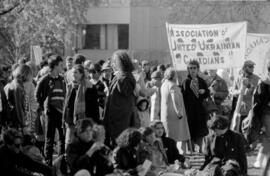Title and statement of responsibility area
Titel
Algemene aanduiding van het materiaal
- Graphic materials (electronic)
Parallelle titel
Overige titelinformatie
Title statements of responsibility
Titel aantekeningen
Beschrijvingsniveau
archiefbewaarplaats
referentie code
Editie
Editie
Edition statement of responsibility
Class of material specific details area
Statement of scale (cartographic)
Statement of projection (cartographic)
Statement of coordinates (cartographic)
Statement of scale (architectural)
Issuing jurisdiction and denomination (philatelic)
Datering archiefvorming
Datum(s)
-
1988 (Vervaardig)
- Archiefvormer
- Toronto Disarmament Network
Fysieke beschrijving
Fysieke beschrijving
1 photograph : b&w ; 8 x10 (digitized)
Publisher's series area
Title proper of publisher's series
Parallel titles of publisher's series
Other title information of publisher's series
Statement of responsibility relating to publisher's series
Numbering within publisher's series
Note on publisher's series
Archivistische beschrijving
Naam van de archiefvormer
Institutionele geschiedenis
The Toronto Disarmament Network came together in the spring of 1981, following a series of events called Survival and Disarmament Week (12-17 April 1981), organized by the Toronto Chapter of the World Conference on Religion for Peace (WCRP). The week’s activities were supported by about twenty local peace and disarmament groups, including the Cruise Missile Conversion Project, Youth Corps, and Women’s Action for Disarmament. Following Survival and Disarmament Week, still in April 1981, the WCRP called a meeting attended by representatives of a dozen local peace groups. This is where the Toronto Disarmament Network was ultimately formed. The following month, representatives officially named the network and set out its guidelines as follows:
“The Toronto Disarmament Network will share information regarding activities and programs of its member organizations through a regular or occasional activity sheet and by providing a forum for meetings of representatives of member organizations as desired. It will not speak or act in its own name. It may facilitate the formation of coalitions around specific events. Names of organizations participating in such coalitions will be specifically listed.”
Initially, the Network had no formal structure other than monthly meetings and temporary ad hoc committees organised around specific disarmament events. The network organized disarmament actions including demonstrations on August 6th and October 22nd (to mark Hiroshima and the Cuban Missile Crisis, respectively), a Nuclear Weapons Free Zone campaign, and a joint conference with ACT (Against Cruise Testing). They also helped to organize the “Refuse the Cruise” March in October 1983 against Litton Industries, a Canadian manufacturer of American cruise missile components.
-----
Le Réseau de désarmement de Toronto s'est constitué au printemps 1981, à la suite d'une série d'événements appelés Semaine de la survie et du désarmement (12-17 avril 1981), organisés par la section de Toronto de la Conférence mondiale des religions pour la paix (CMRP). Les activités de la semaine ont été soutenues par une vingtaine de groupes locaux pour la paix et le désarmement, dont le Cruise Missile Conversion Project, Youth Corps et Women's Action for Disarmament. Après la Semaine de la survie et du désarmement, toujours en avril 1981, le PMRC a convoqué une réunion à laquelle ont participé des représentants d'une douzaine de groupes pacifistes locaux. C'est à cette occasion que le Réseau de désarmement de Toronto a été créé. Le mois suivant, les représentants ont officiellement baptisé le réseau et défini ses lignes directrices comme suit :
« Le Toronto Disarmament Network partagera des informations sur les activités et les programmes de ses organisations membres par le biais d'une feuille d'activité régulière ou occasionnelle et en fournissant un forum pour les réunions des représentants des organisations membres, si nécessaire. Il ne parlera pas et n'agira pas en son nom propre. Elle peut faciliter la formation de coalitions autour d'événements spécifiques. Les noms des organisations participant à de telles coalitions seront spécifiquement mentionnés ».
Au départ, le réseau n'avait pas de structure formelle autre que des réunions mensuelles et des comités ad hoc temporaires organisés autour d'événements spécifiques de désarmement. Cependant, il a également organisé des actions de désarmement, notamment des manifestations le 6 août et le 22 octobre (pour commémorer Hiroshima et la crise des missiles cubains, respectivement), une campagne en faveur d'une zone exempte d'armes nucléaires et une conférence conjointe avec ACT (Against Cruise Testing). Ils ont également contribué à l'organisation de la marche « Refusez la croisière » en octobre 1983 contre Litton Industries, un fabricant canadien de composants de missiles de croisière américains.

![[Musician playing guitar at Toronto Disarmament Network event]](/uploads/r/archives-et-collections-speciales/b/4/7/b47d6e44087576faf414ff151136ad6148ab806ce84027a169176cea9f9082a3/cfdf3cd8-567f-43ad-aa12-0b4ee3c5666d-30_021_R1-01_142.jpg)
![[Musician playing guitar at Toronto Disarmament Network event]](/uploads/r/archives-et-collections-speciales/2/1/7/217f49f5b7f8cdac69b6476355eae110d0a09539d85dc119bd8d1359089176db/4c25b4a5-4a6b-4eec-87a0-0c6bfad2a52b-30_021_R1-02_142.jpg)
![[Musician playing guitar at Toronto Disarmament Network event]](/uploads/r/archives-et-collections-speciales/d/e/3/de3dbd569fae51d27854b3e51309a55fd41a2334d81cc7c038e1206f49d082ea/45ac1fb8-9cc7-4d80-9857-74c3a68f1211-30_021_R1-03_142.jpg)


![A group of people holding: "Anglican Peace[maker]" and "He Is The Peace Between Us" signs](/uploads/r/archives-et-collections-speciales/9/d/4/9d4894a142456eedf7d3c09ba7627f63fb2ec648b4189daf6084f596ac864f6b/42276764-2474-4583-85df-9a5f0efc30e9-30_021_R1-06_142.jpg)



